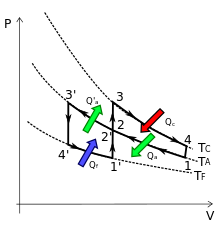Vuilleumier cycle

The Vuilleumier cycle is a thermodynamic cycle that was patented in the USA in 1918 by its inventor Rudolph Vuilleumier . The German patent was published in 1924. The process is a thermally regenerative gas cycle process similar to the process of a Stirling engine . In contrast to the Stirling process, the Vuilleumier process is used counterclockwise in heat pumps and refrigeration machines.
Components
In a Vuilleumier pump, similar to the Stirling engine, there are the following components:
for use. With the Stirling, there is also the working piston . If you connect two Stirling machines together, you can set up the first as a prime mover, which is operated by means of a thermal energy source, and the second as a work machine, namely as a mechanically operated heat pump.
The Vuilleumier pump consists of two compressor elements (displacement pistons) connected in series with three temperature levels. The compressor elements separate a constant gas volume into three oscillatingly changing partial volumes V1, V2, V3. The volumes V1 and V3 absorb heat, the volume V2 releases heat. A regenerator R1, R2 and a compressor element K1, K2 are located between V1 and V2 and between V2 and V3.
Phases
The individual phases of the cycle are as follows:
- Phase I: The displacement piston K1 minimizes the volume V1, the regenerator R1 absorbs its maximum amount of heat, the volume V2 reaches its maximum, the displacement piston K2 minimizes the volume V3 somewhat out of phase with the minimum volume V1. The temperature in V3 is higher than the outside temperature on the cooling surfaces and thus gives off thermal energy. The temperature in V3 cools down.
- Phase II: The volume in V3 is reduced by the extraction of heat, the piston K1 increases the volume V1, which is now warmed up by the regenerator R1 and an external heat source. The volume V3 is minimal.
- Phase III: The volume V3 is increased, the resulting negative pressure and the regenerator R2 cools the gas in V3 and absorbs heat from the environment. The volume V2 is minimal.
- Phase IV: The piston K1 moves upwards, the volume V2 increases, the volume V1 decreases.
The following physical relationships apply:
- In phase I and II, thermal energy is released from the volume V2 to the outside ( compression heat ).
- The total pressure increases steadily in phase I and II ( isothermal pressure increase ).
- In phase III and IV, thermal energy is absorbed from volume V1 and V3 ( expansion cooling ).
- The total pressure decreases steadily in phase III and IV ( isothermal expansion ).
application areas
The Vuilleumier heat pump has so far been built for very special purposes, for example for cooling infrared sensors or for cooling fishing boats. At the moment (as of 2000) some interesting research is being carried out in this area, since new types of materials are greatly expanding the range of applications (e.g. for heating drinking water and space heating) of this heat pump.
The working gas is u. a. Helium or hydrogen are used.
See also
Individual evidence
- ↑ US1275507 A
- ↑ https://www.google.co.in/patents/DE402305C
- ↑ a b http://www.bine.info/publikationen/publikation/vuilleumier-waermepumpen/
- ↑ a b http://www.bine.info/fileadmin/content/Publikationen/Projekt-Infos/2000/Projekt-Info_01-2000/projekt_0100_internetx.pdf
- ↑ a b http://www.google.co.in/patents/DE4206958A1?cl=de



